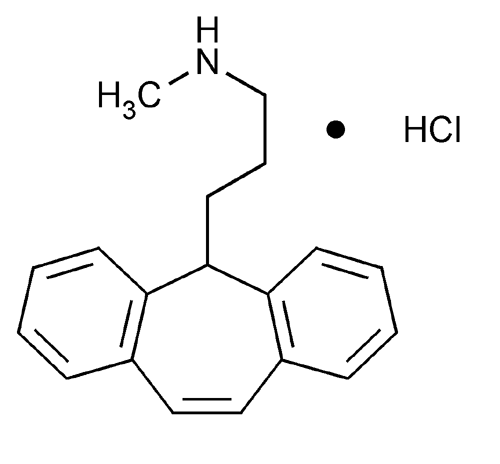Protriptyline Hydrochloride
5H-Dibenzo[a,d]cycloheptene-5-propanamine, N-methyl-, hydrochloride.
N-Methyl-5H-dibenzo[a,d]cycloheptene-5-propylamine hydrochloride
» Protriptyline Hydrochloride contains not less than 99.0 percent and not more than 101.0 percent of C19H21N·HCl, calculated on the dried basis.
Packaging and storage—
Preserve in well-closed containers.
USP Reference standards  11
11 —
—
USP Protriptyline Hydrochloride RS.
USP Protriptyline Hydrochloride RS.
Identification—
Solution:
10 µg per mL.
Medium:
0.1 N methanolic hydrochloric acid.
Absorptivities at 292 nm, calculated on the dried basis, do not differ by more than 3.0%.
C:
It responds to the test for Chloride  191
191 , when tested as specified for alkaloidal hydrochlorides.
, when tested as specified for alkaloidal hydrochlorides.
D:
Its X-ray diffraction pattern (see X-ray Diffraction  941
941 ) conforms to that of USP Protriptyline Hydrochloride RS.
) conforms to that of USP Protriptyline Hydrochloride RS.
pH  791
791 :
between 5.0 and 6.5, in a solution (1 in 100).
:
between 5.0 and 6.5, in a solution (1 in 100).
Loss on drying  731
731 —
Dry it at a pressure below 5 mm of mercury at 60
—
Dry it at a pressure below 5 mm of mercury at 60 to constant weight: it loses not more than 0.3% of its weight.
to constant weight: it loses not more than 0.3% of its weight.
Residue on ignition  281
281 :
not more than 0.1%.
:
not more than 0.1%.
Heavy metals, Method II  231
231 :
0.001%.
:
0.001%.
Assay—
Transfer about 700 mg of Protriptyline Hydrochloride, accurately weighed, to a 125-mL conical flask, and dissolve in 30 mL of glacial acetic acid. Add crystal violet TS and 10 mL of mercuric acetate TS, and titrate with 0.1 N perchloric acid VS to a green endpoint. Perform a blank determination, and make any necessary correction. Each mL of 0.1 N perchloric acid is equivalent to 29.98 mg of C19H21N·HCl.
Auxiliary Information—
Please check for your question in the FAQs before contacting USP.
Chromatographic Column—
| Topic/Question | Contact | Expert Committee |
| Monograph | Ravi Ravichandran, Ph.D.
Senior Scientist 1-301-816-8330 |
(MDPP05) Monograph Development-Psychiatrics and Psychoactives |
| Reference Standards | Lili Wang, Technical Services Scientist 1-301-816-8129 RSTech@usp.org |
USP32–NF27 Page 3437
Chromatographic columns text is not derived from, and not part of, USP 32 or NF 27.
